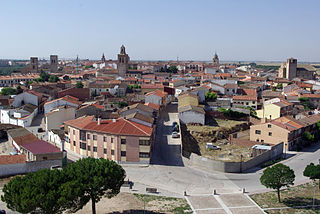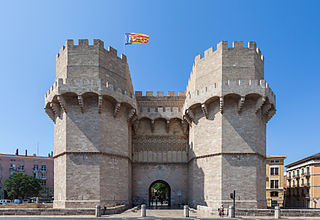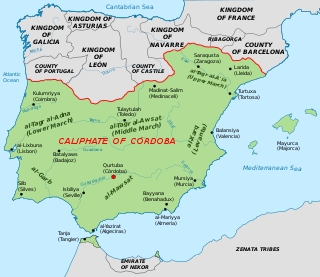
Saint Francis Borgia, 4th Duke of Gandía (1510–1572) was a great-grandson of Pope Alexander VI, a Grandee of Spain, a Spanish Jesuit, and third Superior General of the Society of Jesus. He was canonized on 20 June 1670 by Pope Clement X.

Alzira is a town and municipality of 45,000 inhabitants in Valencia, eastern Spain. It is the capital of the comarca of Ribera Alta in the province of Valencia.

The Alcázar de los Reyes Cristianos, also known as the Alcázar of Córdoba, is a medieval alcázar located in the historic centre of Córdoba, next to the Guadalquivir River and near the Grand Mosque. The Alcázar takes its name. The fortress served as one of the primary residences of Isabella I of Castile and Ferdinand II of Aragon.
The hereditary Spanish title duke of Gandía has its origin in the "Manorialism of Gandía" founded in 1323 by James II of Aragon and was created in 1399 as Duke of Gandía by Martin of Aragon and granted to Alfonso of Aragon and Foix. Later, having no direct descendants, the title passed from the House of Aragon to the House of Trastámara. The title was re-established in 1483 by Ferdinand II of Aragon as a favour to Cardinal Rodrigo Borgia for his son Pedro Luis.

Castelló de Rugat is a municipality in the comarca of Vall d'Albaida in the Valencian Community, Spain.

Arévalo is a municipality in Spain, it is situated in the province of Ávila and is part of the autonomous community of Castile and León. The name came from the Celtic word arevalon, meaning "place near the wall."

The Monastery of Sant Jeroni de Cotalba is a monastic building of Valencian Gothic, Mudéjar, Renaissance, Baroque and Neoclassical styles constructed between the 14th and 18th centuries, located in the municipal area of Alfauir, (Valencia), Spain, about 8 km. from the well-known city of Gandia.
Juan Domingo de Borja y Doncel was a Spanish noble from Aragonese Valencia in the town of Borja, Zaragoza. He held the title over the Señor de la Torre de Canals. He was a member of the House of Borja.

The Route of the Borgias is a cultural route, that includes sites associated with the Borja or Borgia, located in their native Valencian Community, Spain. The marketing of the route was inaugurated in 2007.

The Ducal Palace of Gandia was, from the 14th century, the residence of the Royal Dukes of Gandía, and from 1485, the Borja family. It was the birthplace of Saint Francis Borja.

The Palace of the Borgias is an aristocratic palace of Valencian Gothic and Renaissance styles located in the city of Valencia, Spain. It is now the headquarters of the Valencian Parliament.

The Convent of Santa Clara is 15th-century, Roman Catholic convent belonging to cloistered order of the Colettine Poor Clares, and located in the town of Gandia, province of Valencia, Spain. It is located in the centre of Gandia and at few meters from the Collegiate Basilica of Gandia, in María Enríquez de Luna square.

The Oratory of the Borgias or Church of the Tower is located in the municipality of Canals (Valencia), Spain. It is a church built in early Valencian Gothic style, probably in the 13th century.
The Señorío de Torre de Canals or the Lordship of Torre de Canals was an independent Christian lordship in the Kingdom of Aragón located in and around the town of Torre de Canals. The town is located in the present day Valencian Community and no longer exists as a lordship.

The Route of the Valencian classics,, is a cultural route through the lands of the great classical writers of the Valencian literature of the Valencian Golden Age: Ausiàs March, Joanot Martorell and Joan Roís de Corella, the three related to the court of the Duke Alfonso of Aragon and Foix, "the Old".

The Serrans Gate or Serranos Gate, also known as Serrans Towers or Serranos Towers is one of the twelve gates that formed part of the ancient city wall, the Christian Wall, of the city of Valencia, Spain. It was built in Valencian Gothic style at the end of the 14th century. Its name is probably due to its location in the northeast of the old city centre, making it the entry point for the royal road connecting Valencia with the comarca or district of Els Serrans as well as the entry point for the royal road to Barcelona, or because the majority of settlers near there in the time of James I of Aragon were from the area around Teruel, whose inhabitants were often called serrans by the Valencians. Alternatively, the gate may also have been named after an important family, the Serrans, who lived in a street with the same name.

The Muslim Walls of Madrid, also known as the Arab Walls of Madrid, of which some vestiges remain, are located in the Spanish city of Madrid. They are probably the oldest construction extant in the city. They were built in the 9th century, during the Muslim domination of the Iberian Peninsula, on a promontory next to Manzanares river. They were part of a fortress around which developed the urban nucleus of Madrid. They were declared an Artistic-Historic Monument in 1954.




















